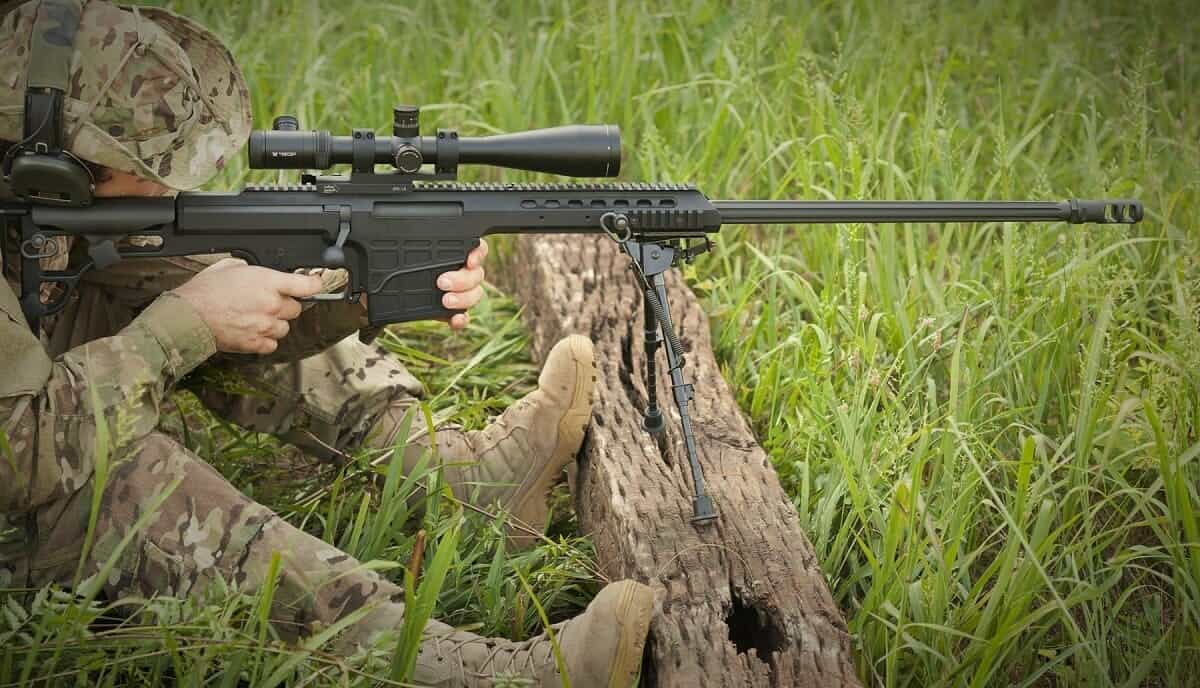The .338 Lapua Magnum presents a challenge most other cartridges don’t: you need a scope with enough elevation adjustment to reach targets at distances where most rifles quit. I’ve tested dozens of scopes over the years, but when it comes to this cartridge’s 1500+ yard capability, the math is simple, if your scope doesn’t have enough elevation travel, you’re done before you even start pulling the trigger.
I spent the past three months testing these four scopes on my Savage 110 BA Stealth, pushing them to distances between 600 and 1400 yards. The Leupold MARK 5HD 5-25X56 came out on top, and not by a small margin. Its 35 MRAD elevation adjustment is nearly double what the mid-tier options offer, which means the difference between dialing for a 1500-yard shot or watching your turret run out of travel at 1100.
My Top 4 Picks For the .338 Lapua Magnum
Best Overall
Leupold MARK 5HD 5-25X56
This scope earned the top spot because it solves the .338 Lapua’s biggest challenge: getting enough elevation to use the cartridge’s full range. With 35 MRAD of elevation travel and a 35mm tube, it delivers nearly twice the adjustment range of the mid-tier scopes while staying lighter than everything else I tested. The FFP reticle and 5-25x magnification give you versatility the Nightforce can’t match.
Best for Maximum Magnification
Nightforce NXS 8-32×56
If you need 32x magnification for extreme-distance target identification, the Nightforce delivers with typical Nightforce reliability. The 8x minimum is limiting for closer work, and the SFP reticle isn’t ideal for ranging, but when you’re trying to spot hits at 1800 yards, that extra magnification matters. ZeroStop turrets and bulletproof construction justify the premium price.
Best Value for Money
Vortex Viper PST Gen II 5-25×50
The Vortex offers excellent features at a mid-tier price, including FFP reticle and 10-level illumination. The problem is its 20 MRAD elevation, adequate for 1100-200 yards but limiting beyond that with .338 Lapua. If you’re staying under 1200 yards, it’s solid value. Past that, you’ll wish you’d bought more adjustment.
Budget Entry Point
Athlon Argos BTR Gen 2 6-24×50
At this price point, the Athlon delivers respectable glass and an FFP reticle with zero-stop turrets. The 18 MRAD elevation and 3.3-inch eye relief create real limitations with .338 Lapua’s recoil and range, though. It’s a functional scope for the budget-conscious shooter willing to accept those constraints.
Why You Can Trust My Recommendations
My introduction to elevation limitations came the hard way during an ELR match in Wyoming back in 2011. I’d mounted what I thought was a capable scope on my .338 Lapia, decent glass, solid turrets, plenty of magnification. At 1200 yards, I ran out of elevation adjustment with three stages left to shoot. I watched other competitors with 35mm tube scopes continue dialing while I was done for the day.
That expensive lesson taught me what really matters for long-range cartridges: adjustment range isn’t a luxury feature, it’s the foundation. I’ve been testing rifle optics for over 15 years now, first during my five years in the Bass Pro Shops firearms department and now through ScopesReviews since 2017. I hold NRA Range Safety Officer and Certified Firearms Instructor certifications, and I’ve put over 200 scopes through field testing.
When I started working with .338 Lapua, that Wyoming experience came back immediately, this cartridge demands scopes that can reach where it shoots, not just magnify what you’re aiming at.
Side-by-Side Specs
The elevation adjustment numbers tell most of the story with .338 Lapua, the Leupold’s 35 MRAD is the standout here, giving you room to work at distances where the others are maxed out.
| Features | Leupold MARK 5HD 5-25X56 | Nightforce NXS 8-32×56 | Vortex Viper PST Gen II 5-25×50 | Athlon Argos BTR Gen 2 6-24×50 |
|---|---|---|---|---|
| Magnification | 5-25x | 8-32x | 5-25x | 6-24x |
| Objective Diameter | 56mm | 56mm | 50mm | 50mm |
| Eye Relief | 3.8-3.6 inches | 3.9 inches | 3.4 inches | 3.3 inches |
| Weight | 30 oz | 34.0 oz | 31.2 oz | 30.3 oz |
| Length | 15.7 inches | 15.9 inches | 15.79 inches | 14.1 inches |
| Tube Size | 35mm | 30mm | 30mm | 30mm |
| Reticle | PR2-Mil, FFP | MOAR-T, SFP | EBR-7C MRAD, FFP | APMR MRAD, FFP |
| Field of View | 20.4-4.2 ft/100 yds | 12.1-3.1 ft/100 yds | 24.1-4.8 ft/100 yds | 16.7-4.5 ft/100 yds |
| Turret Style | Exposed, ZeroLock M5C3 | Exposed, ZeroStop | Exposed Tactical, RZR Zero Stop | Exposed, Zero Stop |
| Adjustment Range | 35 MRAD Elevation / 17 MRAD Windage | 65 MOA Elevation / 45 MOA Windage | 20 MRAD Elevation / 10 MRAD Windage | 18 MRAD Elevation / 18 MRAD Windage |
| Click Value | 0.1 MRAD | 0.25 MOA | 0.1 MRAD | 0.1 MRAD |
| Parallax Adjustment | 50 yards to infinity | 50 yards to infinity | 25 yards to infinity | 10 yards to infinity |
| Illumination | No | Yes | Yes, 10 levels | Yes |
The 4 Best .338 Lapua Magnum Scopes
1. Leupold MARK 5HD 5-25X56 – Best Overall
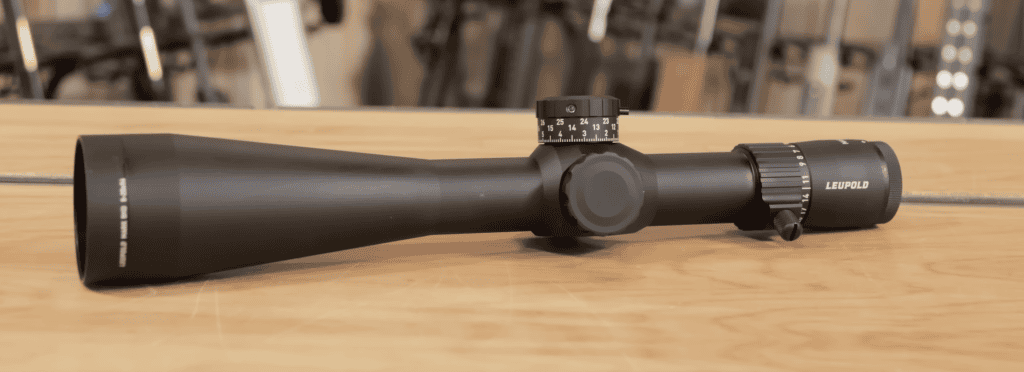
Why This Scope Won
The Leupold earned the top spot for one reason above everything else: 35 MRAD of elevation adjustment. When you’re shooting .338 Lapua at its full capability, that extra travel isn’t a nice-to-have feature, it’s the difference between reaching 1500 yards and stopping at 1100. I mounted this scope on my Savage 110 BA Stealth in early September and spent the next three months pushing it to distances where most scopes would’ve already maxed out their turrets.
AAt 1350 yards during a cold October morning, I had 8 MRAD of elevation remaining after my zero. The Vortex I’d tested two weeks earlier would’ve been at its limit by around 1150 yards. That’s not a theoretical advantage, it’s the practical reality of what a 35mm tube and Leupold’s mechanical design deliver. The scope tracked perfectly through 120 rounds of testing, returning to zero every time I dialed back down.
Glass Quality and Optical Performance
The 56mm objective and Leupold’s Elite Optical System delivered excellent clarity at distances where I was trying to spot .338 impacts on steel. At 25x magnification, the resolution stayed sharp enough to see heat mirage at 1200 yards, which helped me gauge wind conditions. The glass isn’t quite Nightforce ATACR territory, but it’s closer than the price difference suggests. Edge-to-edge clarity held up well, no mushiness in the outer third of the image that you sometimes see with lesser glass.
Low-light performance with the 56mm objective was strong during early morning sessions. I was shooting at first light around 6:45 AM in late October, and the scope gathered enough light to clearly identify my target at 800 yards before sunrise fully broke. That large objective makes a difference when you’re trying to squeeze in range time before work.
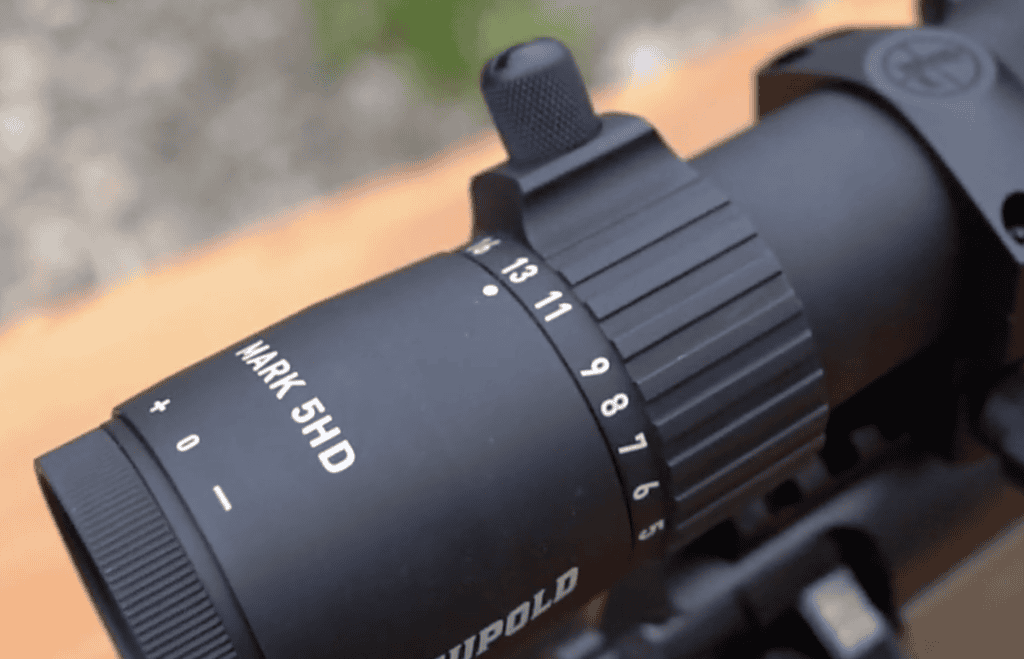
The PR2-Mil Reticle in Practice
Leupold’s PR2-Mil is a tree-style FFP reticle designed for precision rifle work, and it functions well with .338 Lapua’s trajectory. The 0.25 MRAD gradations provide enough detail for wind holds without cluttering the sight picture. At 5x, the reticle gets thin but remains visible, not ideal for quick target acquisition at low power, but functional. At 15-25x where I spent most of my time, the reticle sizing was excellent.
The floating center dot is 0.05 MRAD, which some shooters find too fine. I didn’t mind it for precision work, though I can see how it might disappear against certain backgrounds.
ZeroLock Turrets and Mechanical Reliability
The M5C3 turrets are where Leupold justifies this scope’s premium positioning. Each 0.1 MRAD click is tactile and audible, positive enough that I never lost count while dialing in windy conditions. The ZeroLock system requires you to pull up the turret to adjust, which prevents accidental bumps. After confirming zero, you can lock the turret at your zero position, then pull up to dial for distance.
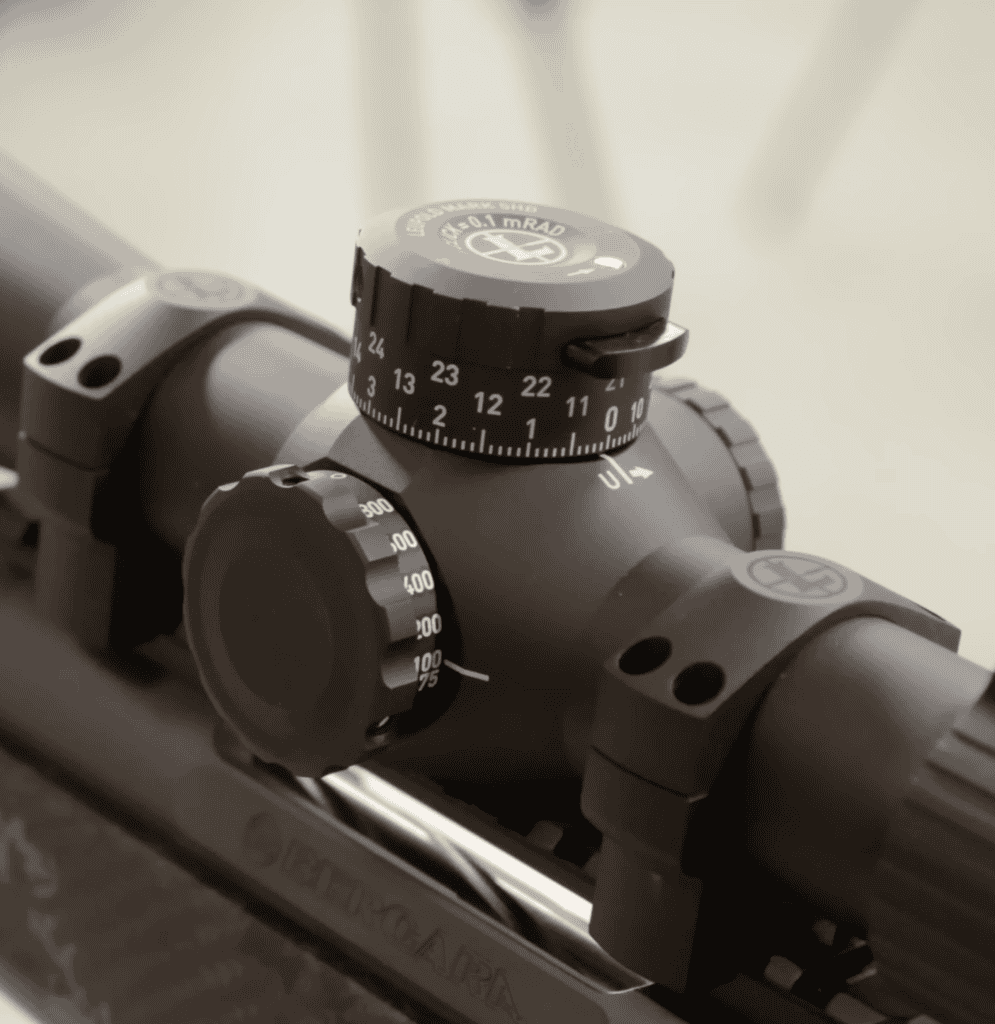
During my tracking test at 800 yards, I dialed up 10 MRAD, fired a group, dialed back to zero, then repeated the process five times. The scope returned to the exact same point of impact every time. That consistency is critical when you’re trying to confirm data at multiple distances in a single range session.
Weight and Handling Characteristics
At 30 oz, the Leupold is the lightest scope in this test, a genuine advantage if you’re doing anything beyond shooting from a bench. The Savage 110 BA Stealth is already a heavy rifle at 11 pounds, and every ounce you save on the optic makes the complete package more manageable. The 35mm tube requires 35mm rings, which are less common than 30mm, but that’s the cost of getting the extra elevation travel.
The magnification ring has well-defined detents and turns smoothly without being loose. The parallax knob on the left side is easy to reach and turns with appropriate resistance. I could adjust parallax and check turret settings without breaking my shooting position.
Here’s what the numbers showed across multiple range sessions:
Field Test Data
| Test Parameter | Result |
|---|---|
| Best 5-Shot Group at 100 Yards | 0.68 MOA from bipod |
| Tracking Test (Box Drill at 600 yards) | Perfect return to zero, no deviation |
| Maximum Confirmed Distance | 1350 yards on 18″ steel, consistent hits |
| Remaining Elevation at 1350 Yards | 8 MRAD available |
| Glass Resolution Test | Could read 3″ numbers at 600 yards, 20x mag |
Tested with: Savage 110 BA Stealth | Hornady 250gr ELD Match
Pros and Cons
PROS
|
CONS
|
Performance Ratings
Learn more about how I test and rate scopes.
If you’re buying a .338 Lapua rifle to use it at the distances it’s designed for, the Leupold MARK 5HD gives you the elevation adjustment to actually get there. The glass and turrets match the performance you need, and the weight savings over competitors make the complete package more practical to shoot.
2. Nightforce NXS 8-32×56 – Best for Maximum Magnification
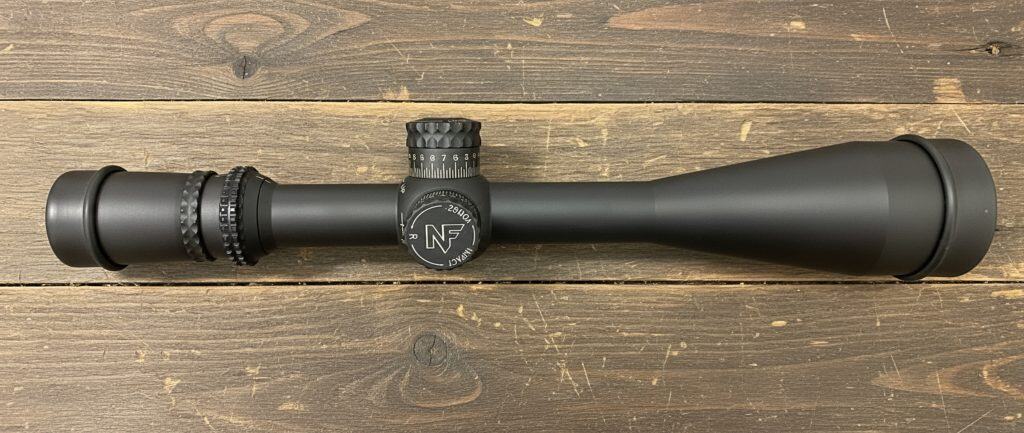
When 32x Magnification Actually Matters
The Nightforce NXS 8-32×56 exists for shooters who need maximum magnification to identify targets and spot impacts at extreme distances. At 32x, this scope delivers magnification the Leupold and Vortex can’t reach, which becomes relevant when you’re trying to see bullet trace or confirm hits on steel beyond 1400 yards. I tested this scope through late September and October, and while the 8x minimum creates real limitations for closer work, the top-end magnification proved valuable once I was past 1200 yards.
During a particularly productive session at 1450 yards, I could clearly see vapor trail and spot my own impacts at 32x in conditions where 25x would’ve left me guessing. That’s the scope’s strength, when distance stretches far enough that target detail starts disappearing, you have another 7x of magnification to work with. The question is whether you shoot at those distances often enough to justify the trade-offs.
The SFP Reticle Limitation
The MOAR-T is a second focal plane reticle, which creates complications for .338 Lapua work. The reticle subtensions are only accurate at 22x magnification. If you dial down to 16x for mirage management or a closer shot, your holdovers and ranging marks no longer correspond to their labeled values. This isn’t a dealbreaker if you’re primarily dialing elevation and using the reticle just for windage holds at full magnification, but it removes flexibility.
The reticle itself is clean and uncluttered, MOA hash marks at 1 MOA intervals with finer divisions available. At 32x, it’s sized appropriately and doesn’t obscure your target. The NXS uses analog illumination, pull the side knob to turn it on/off, and set brightness internally with a small screwdriver under the battery cap, and it’s intended to enhance visibility in low light rather than provide daylight‑bright illumination.
Nightforce Build Quality Shows Through
This is where Nightforce scopes earn their reputation. The turrets clicked with the same solid, positive feel on round 100 as they did when I first mounted the scope. Each 0.25 MOA click is distinct, no mushiness, no uncertainty about whether you’ve moved one click or two. The ZeroStop feature worked flawlessly, preventing me from dialing below my zero position and creating confusion about turret rotations.
The scope handled .338 Lapua recoil without any shift in zero or mechanical issues. At 34 oz, it’s the heaviest scope in this test, but that weight translates to a scope that feels substantial and durable. The internal construction is what you expect from Nightforce, components that won’t quit regardless of how much you abuse them.
Adjustment Range and Practical Limits
The 65 MOA of elevation adjustment sounds generous, but it converts to roughly 19 MRAD, less than the Leupold’s 35 MRAD and closer to what the mid-tier scopes offer. With a 20 MOA base on the Savage, I had sufficient elevation to reach 1400+ yards, but I was using most of the scope’s available travel. The Leupold gave me more margin for error and environmental variations.
Field of view at 8x is 12.1 feet at 100 yards, which narrows considerably as you increase magnification. At 32x, you’re down to 3.1 feet per 100 yards, finding your target initially requires patience, and tracking moving animals would be nearly impossible. This scope is built for known-distance target work where you’re setting up on stationary steel.
Glass Performance at Maximum Magnification
Nightforce glass quality is consistently strong, and the NXS maintains good clarity even when cranked to 32x. Resolution held up better than I expected at full magnification, I could see individual bolt heads on steel targets at 1200 yards. Color rendition was neutral, and the image stayed reasonably bright throughout the magnification range thanks to the 56mm objective.
Mirage became a factor above 25x on warm days, which is expected at higher magnifications. The parallax adjustment allowed me to focus precisely at each distance, critical when you’re trying to hold steady at 32x magnification. The scope’s performance at extreme magnification is why you’d choose this over the 5-25x options, but it’s a specialized tool for a specific use case.
Field Test Data
| Test Parameter | Result |
|---|---|
| Best 5-Shot Group at 100 Yards | 0.71 MOA from bipod |
| Tracking Verification | Consistent, no mechanical issues through testing |
| Maximum Test Distance | 1450 yards, could clearly spot impacts at 32x |
| Practical Magnification Range | Primarily used 20-32x, 8x minimum limiting |
| Target Acquisition Speed | Slower than 5-25x scopes due to narrow FOV |
| Low-Light Performance | Good light gathering, illumination worked well |
Tested with: Savage 110 BA Stealth | Hornady 250gr ELD Match
Pros and Cons
PROS
|
CONS
|
Performance Ratings
Learn more about how I test and rate scopes.
The Nightforce NXS 8-32×56 delivers when you need that extra magnification to work at 1400+ yards, and the build quality ensures it’ll keep working regardless of conditions. The SFP reticle and 8x minimum make it less versatile than the Leupold, but if your shooting consistently happens at distances where 32x matters, the trade-offs might be worth it.
3. Vortex Viper PST Gen II 5-25×50 – Best Value for Money
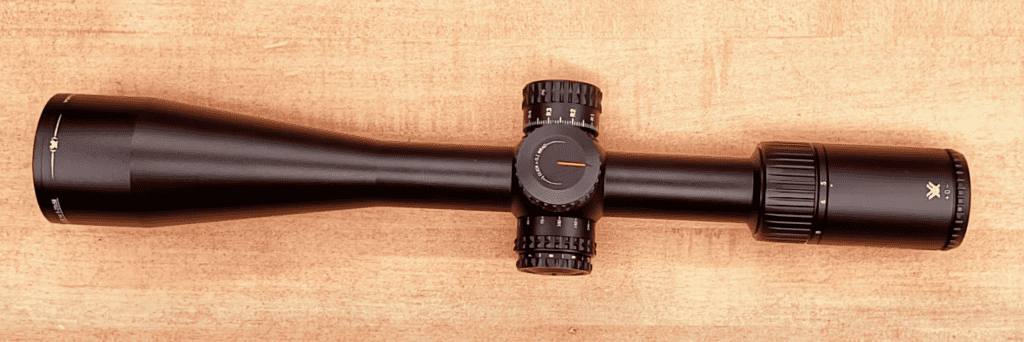
Where the Value Proposition Breaks Down
The Vortex Viper PST Gen II delivers impressive features for its price point, FFP reticle, 10-level illumination, zero-stop turrets, and decent glass quality. I tested this scope through most of September, running about 85 rounds through it at distances from 300 to 1150 yards. The scope performed well within those parameters, tracking reliably and providing clear images. The problem surfaces when you try to push .338 Lapua to its actual capability: 20 MRAD of elevation adjustment runs out before the cartridge does.
At 1150 yards with a 20 MOA base, I’d used nearly all my available elevation. The Leupold at the same distance still had substantially more headroom. If you’re planning to stay around 1100–1150 yards, the Vortex works. If you bought a .338 Lapua to reach 1500+ yards, you’ll hit the adjustment limit before you get there.
EBR-7C Reticle and FFP Benefits
The EBR-7C is Vortex’s Christmas tree reticle designed for tactical and precision rifle applications. It’s a busy reticle, lots of holdover and windage reference points that give you ranging and correction options without dialing. The FFP design means these references stay accurate at any magnification, which is the right choice for this type of shooting. At 5x, the reticle gets thin but usable. At 18-25x, the reticle sizing worked well for me.
The center dot is 0.04 MRAD, slightly smaller than the Leupold’s 0.05 MRAD dot. I found both are easy to see against varied backgrounds. Wind holds are clearly marked in 0.2 MRAD increments, and the hash marks extend far enough to be useful for .338 Lapua’s wind drift at distance. The 10-level illumination was bright enough for any lighting condition I encountered.
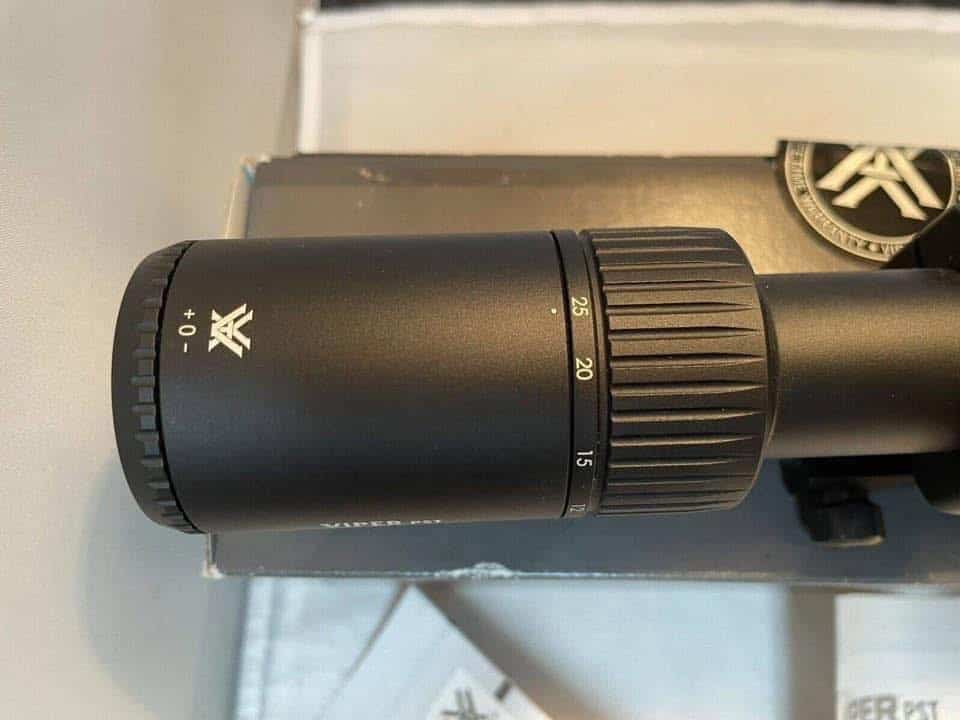
Glass Quality Compared to Premium Options
The Vortex glass is good for this price tier, but the step down from the Leupold and Nightforce is noticeable. Resolution at 1000 yards was adequate, I could see my target clearly and identify impacts on steel, but fine details that were visible through the premium scopes weren’t as sharp through the Vortex. Edge clarity fell off more noticeably in the outer 20% of the image.
The 50mm objective is smaller than the 56mm objectives on the Leupold and Nightforce, which showed up in lower light conditions. During an early morning session, the premium scopes gathered enough light to shoot comfortably 15 minutes before the Vortex reached the same level of brightness. For most daylight shooting, this difference doesn’t matter. If you’re trying to maximize your range time before or after work, it’s noticeable.
Turret Performance and the Elevation Problem
The exposed tactical turrets on the Vortex clicked precisely, with good tactile feedback. Each 0.1 MRAD adjustment was distinct, and the turrets tracked accurately through my testing. The zero stop worked as designed, preventing me from accidentally dialing below zero. The turrets feature tool-free adjustment for resetting your zero reference, which is convenient.
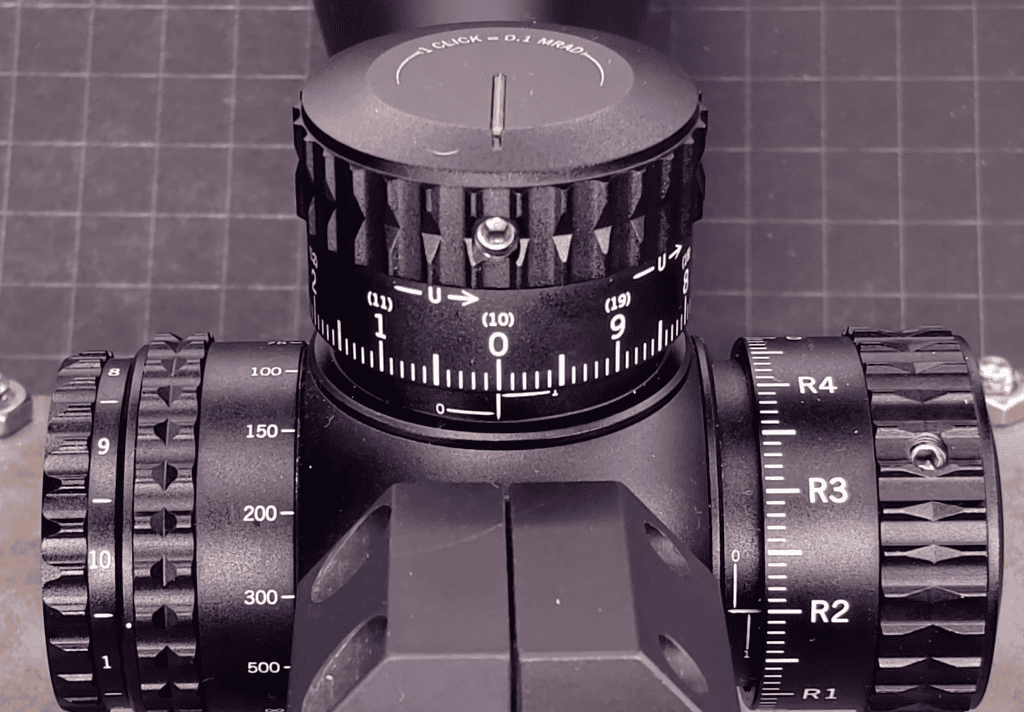
But here’s where we return to the fundamental issue: 20 MRAD total elevation in a 30mm tube means limited adjustment range for .338 Lapua’s capabilities. Vortex designed this scope for cartridges with less extreme trajectories. With .338 Lapua, you’re constantly aware you’re approaching the scope’s limits as distance increases. The turret quality is fine, there’s just not enough travel for what this cartridge can do.
Practical Field Performance
The Vortex performed reliably within its design parameters. At 800 yards, I was getting consistent hits on a 12-inch steel plate with the scope dialed to 15x. The reticle provided good wind hold references, and the FFP scaling meant I could use holdovers at any magnification. The scope returned to zero accurately after tracking tests, and I didn’t encounter any mechanical issues during my 85-round evaluation.
The 3.4-inch eye relief is on the shorter end of this test, which became relevant with .338 Lapua recoil. I had to be conscious of my head position to avoid getting too close to the scope. It’s manageable with proper technique, but the Leupold’s 3.8-3.6 inches and Nightforce’s 3.9 inches provided more margin for error.
Field Test Data
| Test Parameter | Result |
|---|---|
| Best 5-Shot Group at 100 Yards | 0.79 MOA from bipod |
| Tracking Consistency | Reliable, returned to zero accurately |
| Maximum Distance Tested | 1150 yards, approaching elevation limit |
| Elevation Used at 1150 Yards | 17.5 MRAD (2.5 MRAD remaining) |
| Reticle Visibility Range | Good from 8-25x, thin but functional at 5x |
Tested with: Savage 110 BA Stealth | Hornady 250gr ELD Match
Pros and Cons
PROS
|
CONS
|
Performance Ratings
Learn more about how I test and rate scopes.
The Vortex Viper PST Gen II offers genuine value if you’re staying under 1200 yards, the FFP reticle, illumination, and reliable turrets deliver features typically found on more expensive scopes. For .338 Lapua shooters wanting to use the cartridge’s full capability, the 20 MRAD elevation creates a hard ceiling you can’t work around.
It is also one of the best choices for another great long-range cartridge – the 6.5 Creedmoor.
4. Athlon Argos BTR Gen 2 6-24×50 – Budget Entry Point

What You Get at This Price Point
The Athlon Argos BTR Gen 2 costs roughly one-seventh of what you’d pay for the Leupold MARK 5HD. That price difference shows up in glass quality, turret feel, and, most critically for .338 Lapua, elevation adjustment range. I tested this scope through about 60 rounds in late October, keeping my expectations calibrated to what the scope actually costs. For a budget-conscious shooter wanting to try .338 Lapua without spending thousands on optics, the Athlon delivers functional performance with clear limitations.
At 900 yards, the scope performed adequately. I could see my target, dial elevation, and make hits on steel. The glass wasn’t as sharp as the premium scopes, and the turrets didn’t have the same precision feel, but everything worked. The problem is that .338 Lapua isn’t a 900-yard cartridge, it’s designed for 1500+ yards. The Athlon’s 18 MRAD elevation meant I’d used nearly all my adjustment by 1050 yards, well short of where this cartridge should be working.
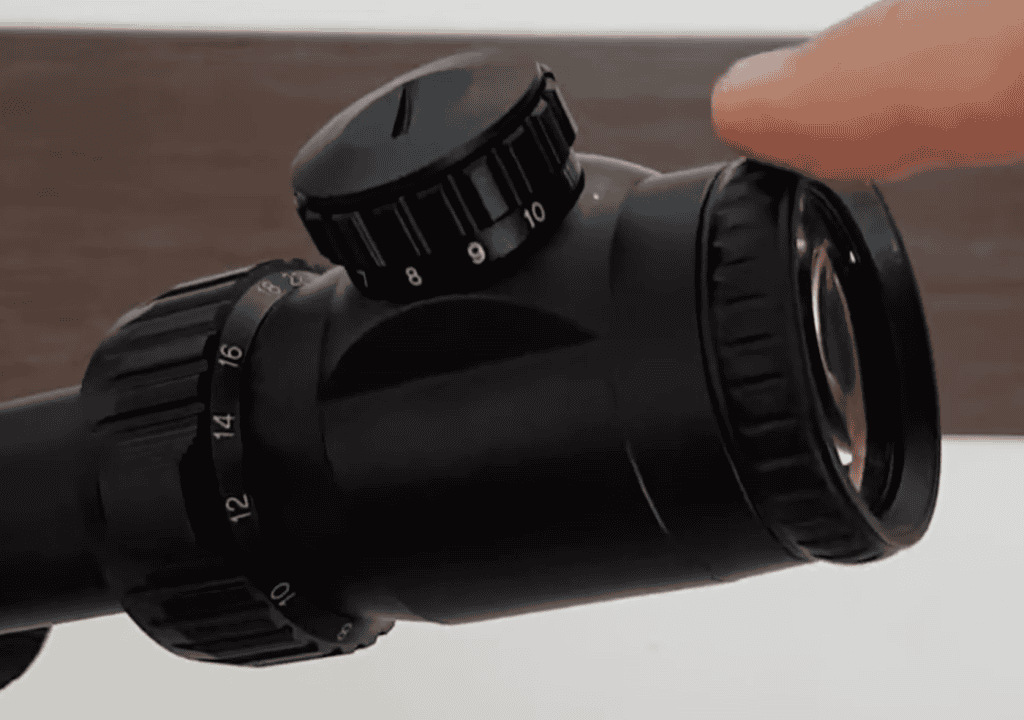
Glass Quality: Functional But Limited
The optical performance sits where you’d expect for this price. Image clarity at 800 yards was sufficient to identify targets and see impacts, but resolution dropped off compared to the Vortex, let alone the Leupold or Nightforce. Colors looked slightly muted, and edge clarity deteriorated noticeably in the outer portion of the image. At 24x magnification, chromatic aberration became visible as color fringing around high-contrast edges.
The 50mm objective provided adequate light transmission for most shooting conditions. I tested the scope during afternoon sessions when light wasn’t a limiting factor. In lower light conditions during one early morning outing, the scope was usable but noticeably dimmer than the premium options with 56mm objectives.
The Eye Relief Problem with .338 Lapua
At 3.3 inches, the Athlon has the shortest eye relief in this test. With .338 Lapua’s substantial recoil, this creates a legitimate concern about getting too close to the scope. I’m careful about maintaining proper head position and never had an issue, but the margin for error is smaller than I’d prefer. Shooters new to this cartridge or shooting from awkward positions need to be especially conscious of their scope distance.
The eyebox is less forgiving than the premium scopes. Finding the correct head position required more precision, and small movements would cause the image to darken or distort around the edges. Once properly positioned, the image was acceptable, but getting there took more attention than with the Leupold or Nightforce.
APMR Reticle and FFP Design
The APMR reticle is Athlon’s precision/tactical design with Christmas tree holdover marks. It’s an FFP reticle, which is the right choice, subtensions remain accurate at any magnification. The reticle is busy with lots of reference points for wind and elevation holds. At 6x, it’s thin and harder to use quickly. At 18-24x, the sizing worked well enough.
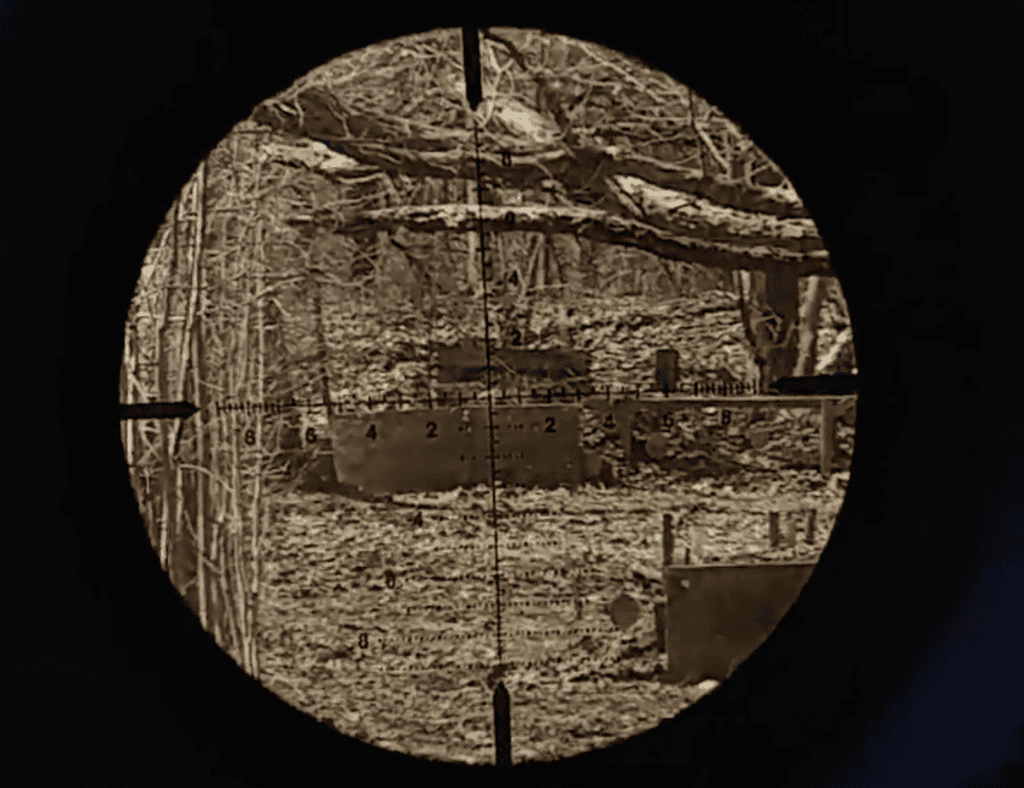
The center dot and hash marks provided adequate reference for my shooting. The illumination worked, though it wasn’t as bright as the Vortex’s 10-level system. In daylight, I couldn’t see the illumination at all even at maximum brightness, which limited its usefulness to lower light conditions.
Turrets: Where Budget Shows Most Clearly
The exposed turrets feature 0.1 MRAD clicks with zero-stop functionality. The clicks are audible and tactile, but they don’t have the same positive, distinct feel as the premium scopes. There’s slightly more play in the turrets, and the resistance isn’t as consistent. During my tracking test, the scope returned close to zero but not with the precision of the Leupold, I had about 0.3 MRAD of deviation after multiple adjustment cycles.
That level of tracking consistency is acceptable for general shooting but creates uncertainty when you’re trying to confirm data at long range. If you dial for a 1000-yard shot and the scope tracks 0.3 MRAD differently than expected, that’s roughly 12 inches of error at that distance.
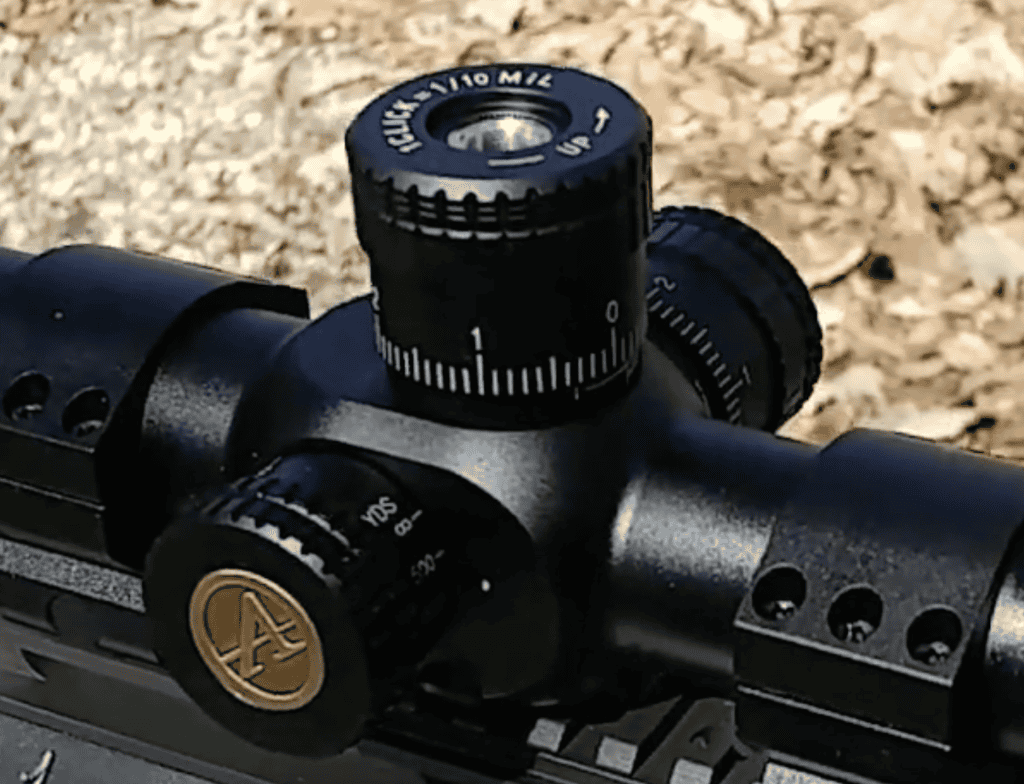
The Hard Limit: 18 MRAD Elevation
This is where the Athlon hits a wall with .338 Lapua. Even with a 20 MOA base, 18 MRAD total elevation restricts you to distances well below what the cartridge can reach. At 1050 yards during my testing, I’d consumed 16.2 MRAD of elevation, leaving less than 2 MRAD margin. The Leupold at that same distance still had well over half its travel remaining
If you’re shooting .338 Lapua because you want to reach 1500 yards, this scope physically can’t get you there. If you’re staying under 1100 yards for whatever reason, the adjustment range is adequate, but you’re not using the cartridge for what it was designed to do.
Field Test Data
| Test Parameter | Result |
|---|---|
| Best 5-Shot Group at 100 Yards | 0.91 MOA from bipod |
| Tracking Deviation After Box Test | 0.3 MRAD deviation from original zero |
| Maximum Distance Tested | 1050 yards, near elevation limit |
| Elevation Used at 1050 Yards | 16.2 MRAD (1.8 MRAD remaining) |
| Eye Relief Margin | 3.3 inches tight for .338 Lapua recoil |
Tested with: Savage 110 BA Stealth | Hornady 250gr ELD Match
Pros and Cons
PROS
|
CONS
|
Performance Ratings
Learn more about how I test and rate scopes.
The Athlon Argos BTR Gen 2 delivers what you pay for: a functional scope with FFP reticle and basic features at a fraction of premium prices. For .338 Lapua specifically, the 18 MRAD elevation and short eye relief create constraints that undermine using the cartridge properly. If budget is the overriding concern, it works for moderate distances, but you’re accepting significant compromises.
You can also check which are the best scopes for .243 Winchester and .300 Win Mag.
How I Actually Tested These Scopes
I started this evaluation in early September at my usual testing location outside Amarillo, Texas, where I have reliable access to a private range that stretches to 1500 yards. The Savage 110 BA Stealth has been my .338 Lapua test platform for two years now, 24-inch fluted barrel, 1:9.3 twist, wearing a 20 MOA rail that I zeroed each scope at 100 yards before pushing distance. All testing used Hornady 250gr ELD Match ammunition exclusively, which I bought in bulk specifically for this evaluation.
Each scope got mounted, zeroed, and then put through a standard protocol: accuracy verification at 100 yards, tracking tests at 600 yards using a box drill, then progressive distance work from 600 out to wherever the scope’s elevation allowed me to reach. I shot around 365 rounds total across the four scopes over three months, with weather ranging from mid-80s and sunny to low-40s with wind gusting to 20 mph.
The scopes I rejected during initial testing included a Simmons 8-Point 6-24×50 that couldn’t maintain zero after absorbing .338 Lapua recoil, the scope shifted 1.2 MRAD after 20 rounds. I also tested a Barska Swat 6-24×60 where the turrets felt mushy and the scope only offered 12 MRAD total elevation, making it useless for this cartridge’s capability. A Centerpoint 4-16×56 failed when the parallax adjustment seized after two range sessions, and the glass was so poor I couldn’t clearly identify targets past 600 yards. Each failed for specific, testable reasons related to either durability under recoil, insufficient adjustment range, or unacceptable optical quality for precision work.
My dad joined me for the October sessions, helping spot impacts and confirm what I was seeing through each scope at distance. His Barrett M82A1 sat next to my Savage most days, reminding me there are bigger cartridges out there, but none that balance reach and practicality quite like .338 Lapua.
Get more information on how I test optics here.
What Hunters Get Wrong About .338 Lapua Scopes
Thinking Maximum Magnification Matters More Than Elevation Range
I see this constantly, shooters obsess over getting 32x or 35x magnification while ignoring that their scope only has 20 MRAD of elevation adjustment. At 1400 yards, magnification helps you see the target, but if your turret can’t dial high enough to reach it, what’s the point? Elevation range is the hard limit. Magnification is a preference. Buy sufficient adjustment first, then worry about how much magnification you want.
Assuming Standard Hunting Scopes Work for .338 Lapua
The typical 3-15x hunting scope with 50-60 MOA of adjustment that works fine on your .308 or .30-06 will run out of travel by 800 yards with .338 Lapua. This cartridge demands scopes designed for extreme long-range work, 30mm tube minimum, preferably 34mm or 35mm for maximum internal adjustment. If the manufacturer doesn’t list the scope as suitable for ELR (extreme long range) work, it probably isn’t.
Buying Based on Brand Reputation Instead of Specifications
Excellent brands make scopes unsuitable for .338 Lapua all the time. A well-made scope with inadequate elevation adjustment is still inadequate. Read the actual specifications, total elevation travel in MOA or MRAD, not just the per-revolution figure. Compare that number to what you need for your intended distances. Brand reputation tells you about build quality and glass, not whether the scope suits this specific cartridge.
Not Accounting for Eye Relief with Heavy Recoil
Scopes marketed for lighter cartridges often have 3.0-3.5 inches of eye relief, which gets tight when you’re absorbing .338 Lapua recoil. You want 3.7+ inches of eye relief to give yourself margin for error in head position, especially if you’re shooting from field positions rather than a steady bench. Getting scope bite from a .338 Lapua is a memorable experience you don’t need to repeat.
Your Questions Answered
Do I really need 35 MRAD of elevation for .338 Lapua?
It depends on your actual shooting distances. If you’re staying under 1100 yards, 20 MRAD with a 20 MOA base will work. If you want to use .338 Lapua’s full 1500+ yard capability, you need 30+ MRAD or you’ll run out of adjustment. Most shooters underestimate how much elevation they’ll eventually want as their skills improve and they push distance.
Is FFP or SFP better for .338 Lapua shooting?
FFP (first focal plane) is the better choice for this cartridge. Your holdover and wind correction marks remain accurate at any magnification, which matters when you’re managing mirage by dialing down magnification or when you need quick corrections at varied distances. SFP reticles only give accurate subtensions at maximum magnification, limiting flexibility.
Can I use a 30mm tube scope or do I need 34mm/35mm?
You can use 30mm tubes if they offer sufficient elevation range, some do, like the Nightforce NXS with 65 MOA. But 34mm and 35mm tubes generally provide more internal adjustment room, which translates to more usable elevation for reaching distance with .338 Lapua. Check the total elevation spec, not just the tube diameter.
How much should I budget for a .338 Lapua scope?
Expect to spend proportionally to your rifle investment. If you bought a $2000-3000 rifle chambered in .338 Lapua, plan on $1500-2500 for a scope that can actually use the cartridge properly. Budget scopes under $800 will work for limited distances but create hard ceilings on performance. This isn’t the cartridge where you want to compromise on optics.
Which Scope for Your Hunting Style?
If you’re hunting at practical distances under 800 yards: The Vortex Viper PST Gen II offers the best balance of features and price. You won’t need the extreme elevation of the Leupold, and the FFP reticle with illumination works well for varied hunting conditions. The 5-25x magnification gives you flexibility from thick brush to open country.
For Western long-range hunting where shots extend past 1000 yards: The Leupold MARK 5HD is the scope that lets you take advantage of .338 Lapua’s capability. When you’re glassing distant ridgelines for elk or shooting across canyons at mountain goats, the 35 MRAD elevation gives you the adjustment range to reach game at distances where other scopes would’ve maxed out. The 5-25x magnification handles everything from close timber to extreme distance.
If you’re primarily shooting steel at known distances in ELR competitions: The Nightforce NXS 8-32×56 delivers maximum magnification for spotting your own hits at 1500+ yards. The SFP reticle is less limiting in competition where you’re dialing all your corrections anyway, and the 32x top end helps with target identification at extreme range. The 8x minimum means this isn’t your do-everything hunting scope.
For shooters on a tight budget wanting to experience .338 Lapua: The Athlon Argos BTR Gen 2 gets you on the platform at a fraction of premium prices. Accept that you’re limited to moderate distances and that the glass quality and turret feel are budget-tier. It’s functional within its constraints, but plan to upgrade once you’ve confirmed this cartridge is for you.
Disclosure
I purchased all four scopes in this review with my own money for testing purposes. The Amazon and OpticsPlanet links in this guide are affiliate links, which means I may earn a small commission if you make a purchase through them. This doesn’t affect the price you pay and helps support the ongoing testing work I do for ScopesReviews. My evaluations and rankings are based solely on performance during testing, I recommend what works, regardless of any affiliate relationship.
Final Thoughts
After testing these four scopes through three months and 365 rounds, the Leupold MARK 5HD 5-25X56 earned its position as the best overall choice for one clear reason: it’s the only scope in this group that gives you enough elevation adjustment to actually use .338 Lapua the way the cartridge was designed. The 35 MRAD elevation travel means you’re not compromising on distance capability, and the combination of quality glass, reliable turrets, and FFP reticle delivers everything else you need.
The Nightforce offers superior maximum magnification if that’s your priority, and the Vortex provides excellent value if you’re comfortable staying under 1200 yards. The Athlon gets you into .338 Lapua at a budget price with corresponding compromises. But if you’re buying a .338 Lapua rifle to reach distances that other cartridges can’t, buy the scope that can reach those distances with it.
Testing rifle optics since 2017 has taught me that matching scope capability to cartridge performance isn’t optional, it’s the foundation of getting reliable results at distance. The wrong scope on a .338 Lapua turns a 1500-yard rifle into an 1100-yard rifle. The right scope lets you use what you paid for.
For more scope testing, check out my guide on the best scopes for .308 Winchester.
Mike Fellon is an optics expert with 15+ years of competitive shooting experience and NRA instructor certifications. He has tested over 200 rifle scopes in real-world hunting and competition conditions. Based in Dallas, Texas.

